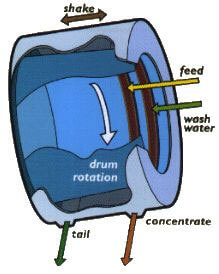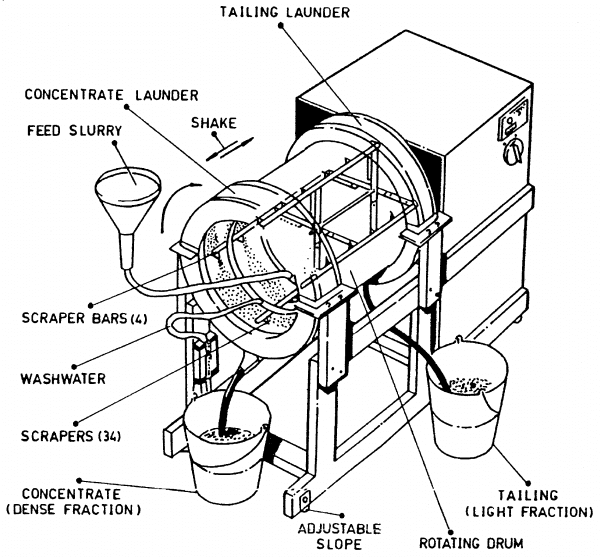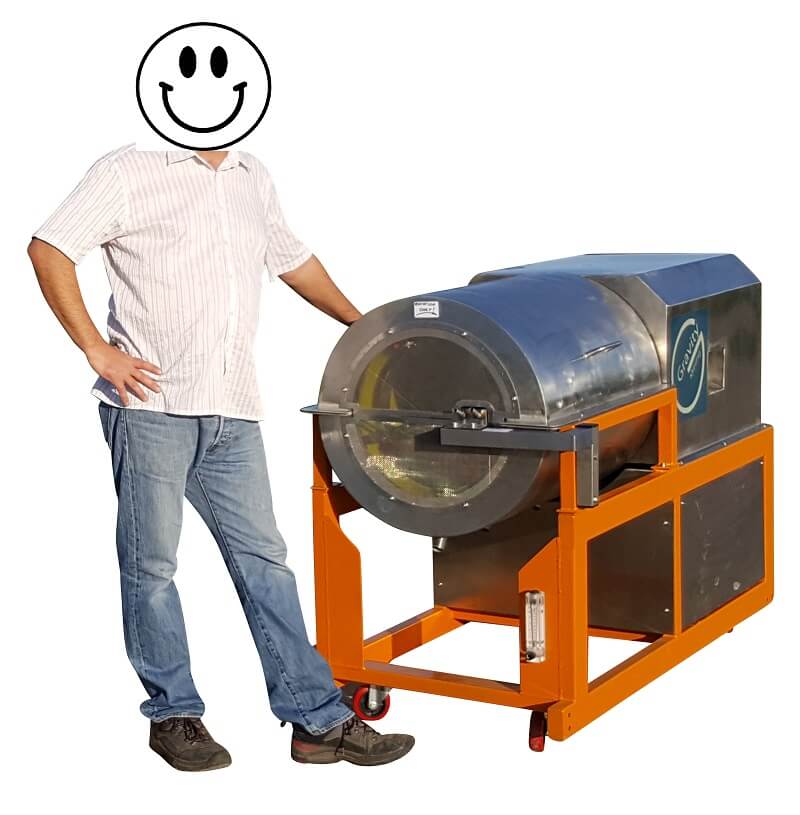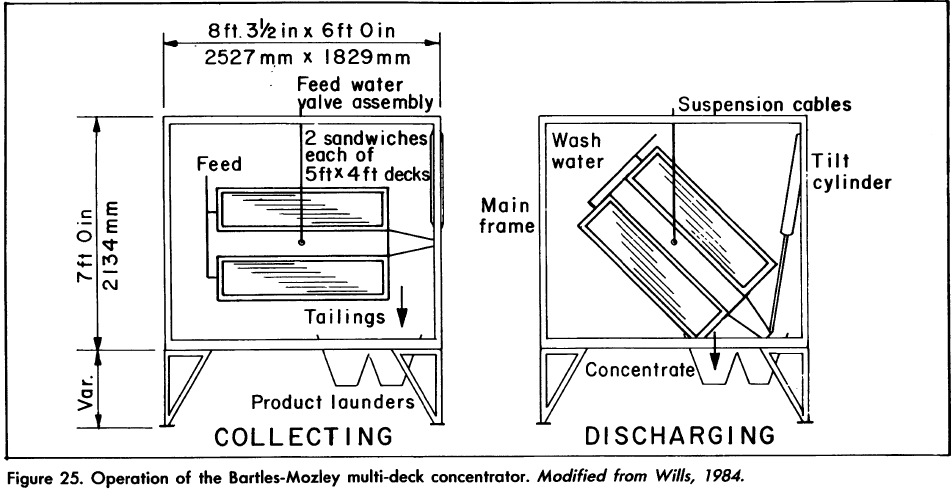The Mozley Super Panner is used for quick and efficient drum separation of mineral groups with distinct density differences and is generally used as a cleaner unit where the mass available for upgrading is very small: typically for Au applications.

A centrifugal solids-liquids separator comprises a rotatable hollow centrifuge drum at least a part of which is tapered, and which is rotatable about its axis, means for introducing a slurry of solids and liquids to be separated at a point along the length of the drum spaced from a wider end so that rotation of the drum tends to cause migration of the slurry towards the said wider end, and scraper conveyor means rotatable about an axis coincident with that of the drum and at a relative speed which is low in relation to the absolute speed of the drum, the scraper conveyor means being so mounted that they act in direct contact with the inside surface of the drum so as to displace solids contacted thereby towards the narrow end of the drum against the axial force induced by the rotation.
MOZLEY MULTI-GRAVITY SEPARATOR
The Mozley separator is operated at a lower G force than the Knelson or Falcon concentrators. It is used for the recovery of ultra-fine particles that have similar specific gravities. The Mozley may allow you to separate Pb from Cu using gravity in a case where it is not possible chemically by flotation.

The Mozley Multi-Gravity Separator is an enhanced gravity device for the separation of fine particles down to one micron size. The rotating action of the drum provides a high gravity force which pins the heavy particles to the drum surface to be removed via the drum scrappers. The shaking motion combined with the selective use of water gives an excellent cleaning effect for maximum particle concentration.
The model C900 is used to perform tests and was designed to treat up to 200 kg/h and is well suited for particles from 1.0 mm down to 1 micron in size. The model C902 Multi-Gravity separator is also available for higher capacity industrial applications. By increasing the total drum area of the standard Multi-Gravity Separator from 3.7 m2 to 20 m2, capacities of 25 t/h and 50t/h per machine may be readily achieved for heavy mineral and coal. Moreover, the geometry of the drum also allows permutations in scraper arrangements which will extend the capacity still further.

In essence, the Mozley is like a powerful compact shaking table where the traditionally horizontal surface is wrapped into a conical drum, which, when rapidly rotates, develops an enhanced gravitational field suitable for the recovery of ultra fines particles. Particles fed into the unit are separated within a dynamic thin film of water many times the force of gravity. Once the parameters are set, minimal operator attention is required to achieve efficient separation performance.
The main benefits are: selectivity, can treat very fine material (down to one micron), low power consumption, continuous operation, no batch discharge, can separate particles with specific gravity differences as low as 0.5 and replace slime deck table. The unit may be used to upgrade flotation concentrates, concentration of gold, recovery of fine metallics, graphite cleaning, coal desulphurization and soil remediation.
The separator enables release analysis of mineral grains of close specific gravity in the size range below 2 mm and can give additional data to heavy liquid results in the higher S.G. ranges.
It consists of a V profile stainless steel tray with a 1o to 3o slope, which can be made to oscillate with a horizontal amplitude of adjustable from 2 to 4″ and a longitudinal amplitude of 1/4″. An adjustable end knock action ;is also provided.
An irrigation pipe is attached to the tray’s perimeter and a concentrate wash water pipe is situated centrally at the feed end of the tray.
Adjustments are provided for leveling, slope setting and a control panel houses a switch timer, water valves and rotameter.
The separator also has an interchangeable stainless steel tray which is flat and which can be used to predict slime table performance on ultra-fine materials.
After the wetted sample has been added to the tray the cyclic motion stabilizes the mineral particles and stratification takes place. Heavy (usually valuable) mineral sinks to the tray surface and is moved “upstream” by the end knock action, “whereas the lighter (gangue) is carried downstream by the flow of the irrigation water to discharge via a tailings launder.
Interpretation may be done visually, microscopically or by assay analysis of the separator products. These can be divided into middlings and concentrate, separately collected. Approximately 150 grams of sample may be used per test run.
Once established, test run parameters should not be varied for reproducibility to allow comparisons to be made between samples.
Gravity concentration of fines and ultrafines
The Bartles-Mozley separator is probably the most widely used slimes table today. It is used for the recovery of particles from 100 microns (roughly 160 mesh) down to 5 microns and, in some cases, as small as 1 micron. The concentrator is constructed of 40 fiberglass decks, each 3.6 feet wide by 5 feet long arranged in two sections of 20 decks each. Each deck surface is smooth and connected by ½-inch plastic formers which also define the pulp channel. The deck assemblies are supported on two cables tilted at an angle of 1 to 3 degrees.
A piping system feeds each deck of the separator at four points across its width. As the material flows across the decks, an orbital motion is imparted by an out-of-balance electric motor. This orbital motion settles put the smaller, high density particles from the flowing film, while larger, lower density particles flow off the deck to the tailings. After running for a period of up to 35 minutes, feed is shut off. The deck is tilted slightly to drain; then it is tilted further and concentrates are washed into a collection sump (Figure 25). The table is then returned to the normal operating position and processing is resumed.
The Bartles-Mozley concentrator is capable of treating up to 120 gallons per minute of pulp (roughly 20 tons of material per hour). Its high capacity allows for the treatment of dilute pulp with a low content of valuable material. It is suitable for use as a rougher or scavenger. Other advantages include low power consumption, the production of dense, deslimed concentrates, and the use of only small amounts of wash water. The unit is an efficient concentrator of fine material.

